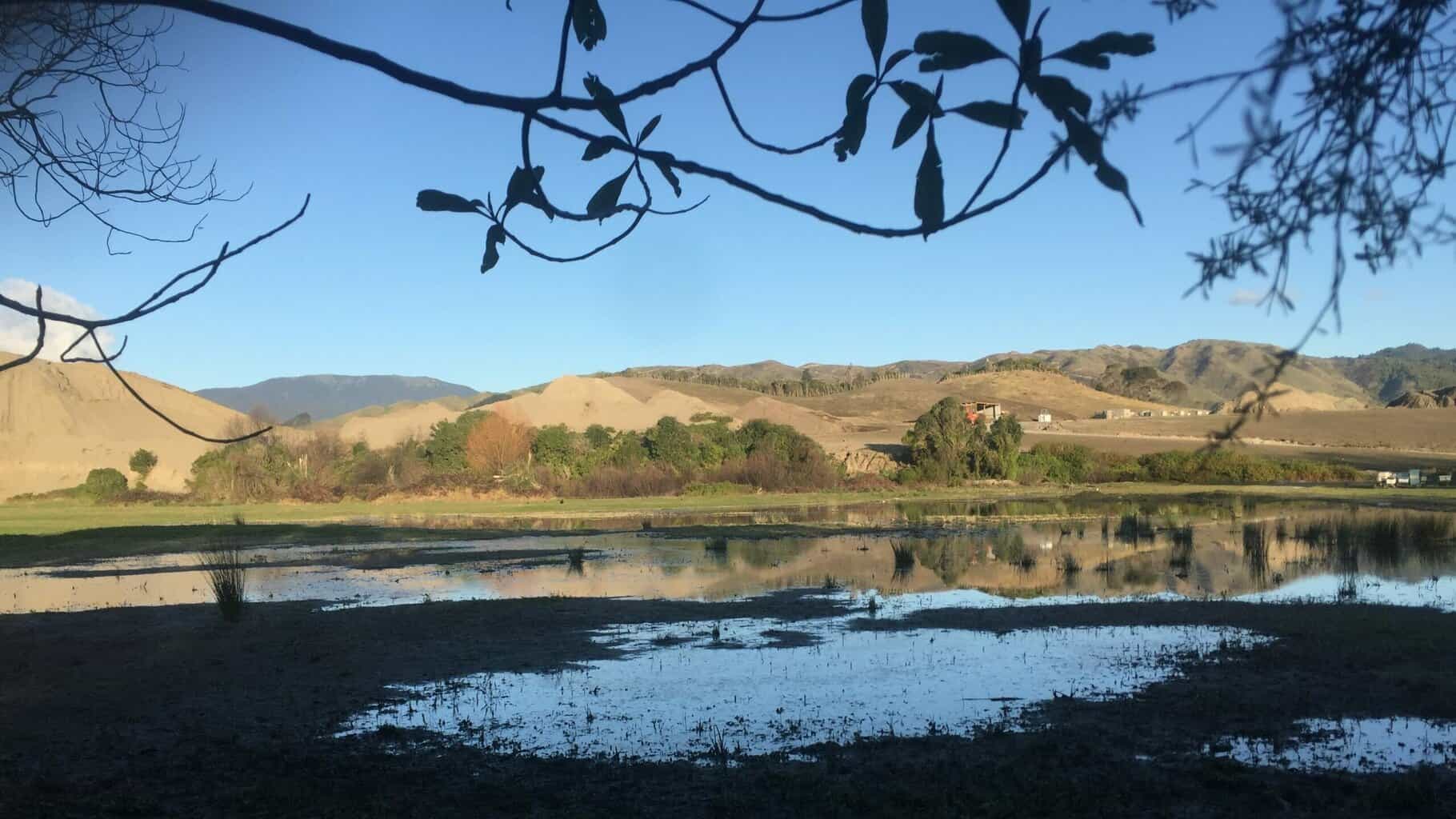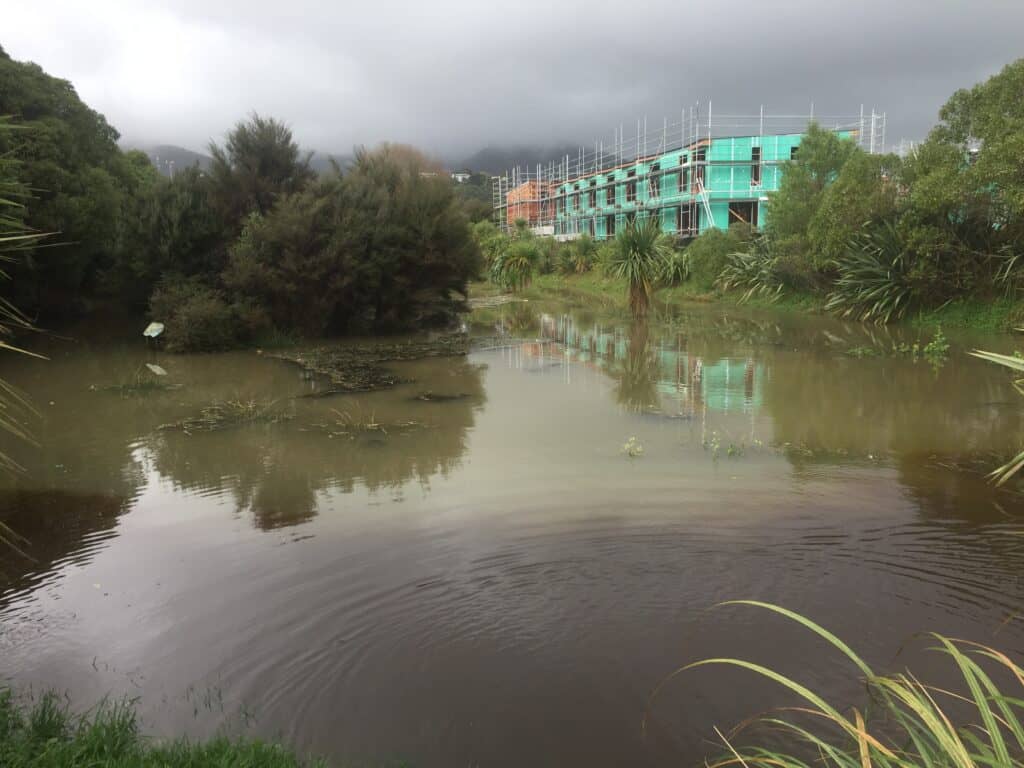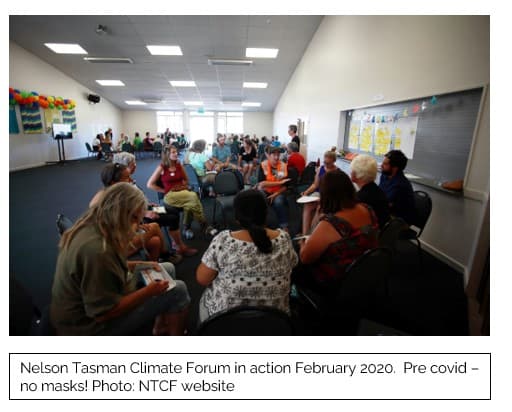By Alison Lash, 27 August 2022
As most of us probably know, much of the Kāpiti coastal plain used to be a swamp. Prior to Pākehā settlement, Māori used and managed the area as a vast food basket. Pākehā settlers were unable to recognise the value of the area as a food source – to their eyes it was “empty” and “unproductive” land. It’s a familiar story and resulted in the felling of the forests and the draining of the swamps in order to create pasture and market gardens.
That was then, this is now. A hundred and fifty years later, we are faced with issues that neither Māori nor Pākeha could have conceived of back then: an over-heating atmosphere, rising seas, increasing floods and more severe droughts. Over the last couple of decades there has been a lot of discussion of these issues as they affect Kāpiti but one issue still seems to fly under the radar – rising ground water levels.
We know from research here and overseas that ground water tables rise in close lock-step with sea levels and that this phenomenon occurs for surprising distances inland. Put very simply, this is because water descending towards the sea from higher ground in underground flows is not able to drain away because of the higher levels of sea water.
About a decade ago, when working at the Kāpiti Coast District Council, I did some very rough early estimates of how many properties in Kāpiti might be affected by this climate change impact. No research by qualified experts (I’m not one of those!) had been done into this particular problem. Nor has there been any since to my knowledge. But the hydrological experts told me it would be a valid proxy to use the number of properties affected by ponding, especially residual ponding, risk in the Council’s flood maps. Depending on the amount of rise in the levels, up to 6,000 properties appeared to be at risk – compared to the 1500-2000 coastal properties which are the focus of the Takutai Kāpiti project. You can find the Council’s flood maps here – take a look and see how many homes around you have a ponding or residual ponding risk.

What are the impacts of permanently saturated soils? Of living on a swamp, in other words?
- Many, if not most, of our houses are built on concrete slabs. These days the slabs are “tanked” – i.e. they are poured into a continuous waterproof membrane that goes all the way underneath and up the sides, effectively isolating the concrete from the damp ground. This was not always the case. When I was a carpentry apprentice in the 1980s, we often only placed the membrane around the outside edge of the slab, leaving the middle unprotected. The basement floor slab of my 1960s Waikanae house is definitely damp much of the time – it is untanked. Such houses can’t be simply jacked up out of contact with the ground as a house on piles could be. Imagine living with a permanently damp slab under your carpet.
- Most local roads around the motu were developed out of old unsealed tracks and roads – often simply by grading the surface and putting a sealed layer over it and then another, and then another over the years. This served to ensure water falling from above ran off and provided a more comfortable ride for those in cars or on bikes. Those roads are not designed to cope with water coming up from below. We Kāpiti Coasters are only too familiar with what happens to roads laid over frequently wet ground – think Raumati Straight prior to the rebuild. They deteriorate rapidly. How will we cope when many of our roads are in that state? How will we pay for the repairs over and over again?
- Many of our smaller neighbourhoods in Kāpiti are on septic tanks. The people who live at the north end of Tilley Rd in Paekākāriki can already tell you how badly septic tanks function when there’s a lot of ground water around after a flood. How about when the ground is permanently saturated? Can we afford to develop new reticulated sewerage systems in Paekākāriki, Te Horo, Peka Peka, the Hautere Plains? Are they big enough communities to make a reticulated system feasible? A certain minimum flow of effluent is needed. It wouldn’t just mean extending the pipe networks, the demand increase would probably require a new wastewater treatment plant.
- And speaking of pipe problems, how are we planning to cope when the pipes of the reticulated schemes start deteriorating rapidly in the permanently wet ground as asbestos cement pipes do, or simply floating in the soil as PVC pipes do, which will destroy the gravity-based drainage systems? Most of our stormwater drainage systems depend on gravity with very small sections of them relying on pumps. If we do have to contemplate wider use of pumped systems, how are we going to cover the pumping costs? Every dollar of the additional electricity bills will go onto rates.
Perhaps some of you are thinking we should put in more open drains, like the Wharemauku. Drainage dependent on gravity is only feasible where a sufficient fall can be achieved from the source to the sea. As sea levels rise, that becomes more and more of a challenge for us in Kāpiti since most of us live on a flat flood plain, a lot of which is less than 20m above sea level, and which is currently sinking. Pumping the groundwater out to sea (assuming we could afford it) is only a solution if we can somehow build a barrier between the sea and the water being pumped, so that it doesn’t just flow back in.
Even if we could engineer our way out of this wicked problem, the private costs for each affected household, and the public costs, which also fall on households in the form of rates, would become crippling.
How much of this is likely to happen and how much only a very worst-case scenario? Which areas will be affected first? What time frames are we looking at?
Clearly, research will be needed to get a handle on the scale of the issue and its geography. I’m sure the Council has this on its radar – no network asset manager responsible for pipes and roads with 50 – 80-year life spans could ignore it indefinitely. Nor could a council charged with consenting new housing for a projected additional 30,000 residents. Once they have the information, they/we will need to come up with ways to address the problems identified.
How do we want to go about that?
There are a couple of very interesting community-led examples of places with similar challenges getting together to work it out that I know of here in Aotearoa. No doubt there are others.
On 23 July, the Dominion Post published an article about how the South Dunedin community is addressing exactly this problem in collaboration with their council. A grassroots community group formed in 2016 to work alongside the council and was made official as the South Dunedin Community Network in 2019 with community governance and council funding for a staff member. Their website indicates the wide range of community issues they deal with. Interestingly, specific research seems to have established that the risk is less urgent than was originally thought it might be. A good reason to conduct such research, surely?
As the entire country has become aware over the last week, the Nelson Tasman area also faces climate challenges, some of which are already beginning to bite. The Nelson Tasman Climate Forum has adopted a slightly different model than the Dunedin group but seems to have elicited good community support.
Both of these groups are community-driven but work with their local councils. It seems to me that the key to success in finding equitable and sustainable solutions for Kāpiti will be significant involvement of the wider community at all stages, right from problem definition through information gathering and assessment of possible options to deciding who pays for the solutions eventually agreed. Without broad community input to and ownership of the process as well as the outcomes, we will inevitably end up in endless delays and fights between groups with different vested interests in the results.
Such an approach would be new for KCDC. The Takutai Kāpiti project is an attempt to include the community more intensively but that model is driven from and by the Council. The Council’s strong desire to be in control of the outcomes of these processes is, I believe, where much of the rather knee-jerk community opposition is born – from the conversation sub-text that tells us that if what we propose does not fit their already-developed ideas, they will discount it.
The model I would prefer to see would be far more community-owned -led, and -driven. The Council is obviously constrained in what it can do by its already-adopted plans and policies and the requirements of the Local Government Act. But a community group is not. Some of the group’s actions and solutions could – and should – be completely independent of Council. Where the Council’s participation was appropriate, it should be on a collaboration basis, with the Council free to opt in or out of agreed actions as it chooses based on its legal and financial constraints. I have not developed my ideas beyond this skeleton framework, as I believe the shape and reach of such a group should be defined by that group, not by me.
Where to from here, then?
With local body elections coming up, I will be raising the groundwater issue wherever I come in contact with candidates. It would be great if you would, too. In the long run, this problem could be far bigger than the coastal erosion issue. Without research we won’t know and without urgent action, it may be too late to develop a really good set of plans which the community strongly supports. The Council will only accelerate this work if they get pressure from Councillors and Community Boards, so let’s vote in some who will do that pushing!
If you like the idea of a community-led response to local climate change impacts in general or to groundwater rise issues in particular, you can contact me through Low Carbon Kāpiti to discuss it further. If enough people are interested, it could fly.



